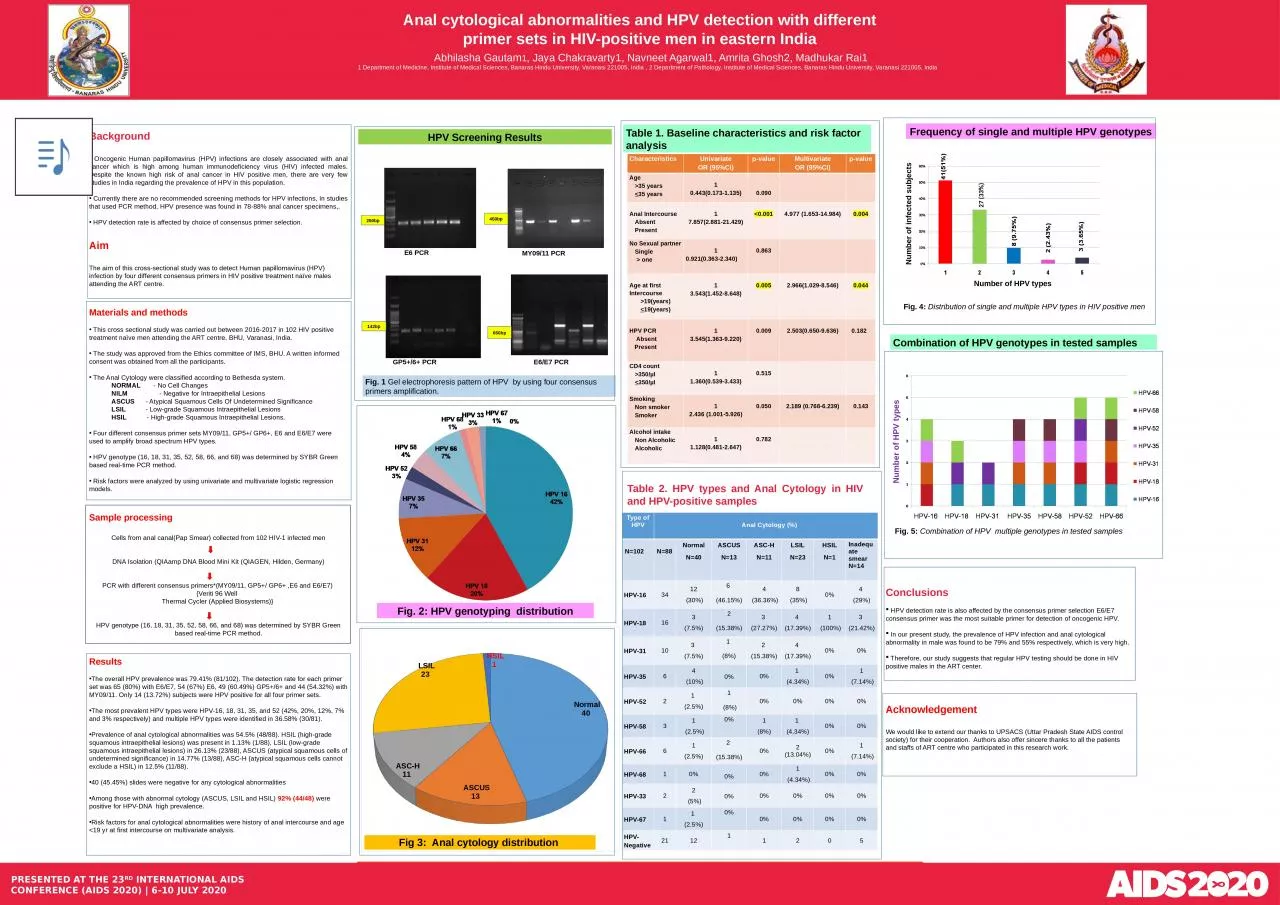

papillomavirus HPV infections are closely associated with anal cancer which is high among human immunodeficiency virus HIV infected males Despite the known high risk of anal cancer in HIV positive men there are very few studies in India regarding the prevalence of HPV in this population ID: 914846
Download Presentation The PPT/PDF document "Background Oncogenic Human" is the property of its rightful owner. Permission is granted to download and print the materials on this web site for personal, non-commercial use only, and to display it on your personal computer provided you do not modify the materials and that you retain all copyright notices contained in the materials. By downloading content from our website, you accept the terms of this agreement.
Slide1
Background
Oncogenic Human papillomavirus (HPV) infections are closely associated with anal cancer which is high among human immunodeficiency virus (HIV) infected males. Despite the known high risk of anal cancer in HIV positive men, there are very few studies in India regarding the prevalence of HPV in this population. Currently there are no recommended screening methods for HPV infections, In studies that used PCR method, HPV presence was found in 78-88% anal cancer specimens,. HPV detection rate is affected by choice of consensus primer selection. Aim The aim of this cross-sectional study was to detect Human papillomavirus (HPV) infection by four different consensus primers in HIV positive treatment naïve males attending the ART centre. Materials and methods This cross sectional study was carried out between 2016-2017 in 102 HIV positive treatment naïve men attending the ART centre, BHU, Varanasi, India. The study was approved from the Ethics committee of IMS, BHU. A written informed consent was obtained from all the participants. The Anal Cytology were classified according to Bethesda system. NORMAL - No Cell Changes NILM - Negative for Intraepithelial Lesions ASCUS - Atypical Squamous Cells Of Undetermined Significance LSIL - Low-grade Squamous Intraepithelial Lesions HSIL - High-grade Squamous Intraepithelial Lesions. Four different consensus primer sets MY09/11, GP5+/ GP6+, E6 and E6/E7 were used to amplify broad spectrum HPV types. HPV genotype (16, 18, 31, 35, 52, 58, 66, and 68) was determined by SYBR Green based real-time PCR method. Risk factors were analyzed by using univariate and multivariate logistic regression models.Sample processingCells from anal canal(Pap Smear) collected from 102 HIV-1 infected menDNA Isolation (QIAamp DNA Blood Mini Kit (QIAGEN, Hilden, Germany) PCR with different consensus primers*(MY09/11, GP5+/ GP6+ ,E6 and E6/E7) {Veriti 96 Well Thermal Cycler (Applied Biosystems)} HPV genotype (16, 18, 31, 35, 52, 58, 66, and 68) was determined by SYBR Green based real-time PCR method.ResultsThe overall HPV prevalence was 79.41% (81/102). The detection rate for each primer set was 65 (80%) with E6/E7, 54 (67%) E6, 49 (60.49%) GP5+/6+ and 44 (54.32%) with MY09/11. Only 14 (13.72%) subjects were HPV positive for all four primer sets.The most prevalent HPV types were HPV-16, 18, 31, 35, and 52 (42%, 20%, 12%, 7% and 3% respectively) and multiple HPV types were identified in 36.58% (30/81).Prevalence of anal cytological abnormalities was 54.5% (48/88). HSIL (high-grade squamous intraepithelial lesions) was present in 1.13% (1/88), LSIL (low-grade squamous intraepithelial lesions) in 26.13% (23/88), ASCUS (atypical squamous cells of undetermined significance) in 14.77% (13/88), ASC-H (atypical squamous cells cannot exclude a HSIL) in 12.5% (11/88). 40 (45.45%) slides were negative for any cytological abnormalitiesAmong those with abnormal cytology (ASCUS, LSIL and HSIL) 92% (44/48) were positive for HPV-DNA high prevalence.Risk factors for anal cytological abnormalities were history of anal intercourse and age <19 yr at first intercourse on multivariate analysis.
Anal cytological abnormalities and HPV detection with different primer sets in HIV-positive men in eastern India
Abhilasha
Gautam1, Jaya Chakravarty1, Navneet Agarwal1, Amrita Ghosh2, Madhukar Rai11 Department of Medicine, Institute of Medical Sciences, Banaras Hindu University, Varanasi 221005, India , 2 Department of Pathology, Institute of Medical Sciences, Banaras Hindu University, Varanasi 221005, India
PRESENTED AT THE 23
RD
INTERNATIONAL AIDS CONFERENCE (AIDS 2020) | 6-10 JULY 2020
Table 2. HPV types and Anal Cytology in HIV and HPV-positive samples
Fig. 5:
Combination of HPV multiple genotypes in tested samples Conclusions HPV detection rate is also affected by the consensus primer selection E6/E7 consensus primer was the most suitable primer for detection of oncogenic HPV. In our present study, the prevalence of HPV infection and anal cytological abnormality in male was found to be 79% and 55% respectively, which is very high. Therefore, our study suggests that regular HPV testing should be done in HIV positive males in the ART center.Acknowledgement We would like to extend our thanks to UPSACS (Uttar Pradesh State AIDS control society) for their cooperation. Authors also offer sincere thanks to all the patients and staffs of ART centre who participated in this research work.
Characteristics
Univariate
OR (95%CI)
p-valueMultivariateOR (95%CI)p-valueAge>35 years<35 years10.443(0.173-1.135)0.090Anal IntercourseAbsentPresent17.857(2.881-21.429)<0.0014.977 (1.653-14.984)0.004No Sexual partnerSingle > one10.921(0.363-2.340)0.863Age at first Intercourse>19(years)<19(years)13.543(1.452-8.648)0.0052.966(1.029-8.546)0.044HPV PCRAbsentPresent13.545(1.363-9.220)0.0092.503(0.650-9.636)0.182 CD4 count>350/µl<350/µl11.360(0.539-3.433)0.515SmokingNon smokerSmoker12.436 (1.001-5.926)0.0502.189 (0.768-6.239)0.143Alcohol intakeNon AlcoholicAlcoholic11.128(0.481-2.647)0.782
Type of HPV
Anal
Cytology (%)N=102N=88NormalN=40ASCUSN=13ASC-HN=11LSILN=23HSILN=1Inadequate smear N=14HPV-163412 (30%)6 (46.15%)4 (36.36%)8 (35%)0%4 (29%)HPV-18163(7.5%)2(15.38%)3 (27.27%)4 (17.39%)1 (100%)3 (21.42%)HPV-31103 (7.5%)1 (8%)2 (15.38%)4 (17.39%)0%0%HPV-3564 (10%)0%0%1 (4.34%)0%1 (7.14%)HPV-5221 (2.5%)1 (8%)0%0%0%0%HPV-5831 (2.5%)0%1(8%)1 (4.34%)0%0%HPV-6661(2.5%)2 (15.38%)0%2 (13.04%)0%1 (7.14%)HPV-6810%0%0%1 (4.34%)0%0%HPV-3322 (5%)0%0%0%0%0%HPV-6711 (2.5%)0%0%0%0%0%HPV-Negative211211205
250bp
450bp
142bp
650bp
HPV Screening Results
E6 PCR
MY09/11 PCR
GP5+/6+ PCR
E6/E7 PCR
Number of HPV types
Number of infected subjects
Fig. 4:
Distribution of single and multiple HPV types in HIV positive men
Frequency of single and multiple HPV genotypes
Table 1. Baseline characteristics and risk factor analysis
Combination of HPV genotypes in tested samples
Number of HPV types
Fig. 1
Gel electrophoresis pattern of HPV by using four consensus primers amplification.
Fig. 2: HPV genotyping distribution
27 (33%)